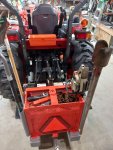Hi All,
We just purchased the unit, and have been going in circles trying to get information on what weight is needed to counter balance for loaded bucket.
kubots says to follow manual, it states the tires need to be filled, and rear attachment, or a heavy rear attachment...? what is heavy? backhoe only..?
dealership has to reference to this, and dont know what consists of "heavy attachment" equals in weight.
i dont want the unit to be any heavier than needed, to help prevent sinking in wetland,, (we have several ac to try to work on following river,, mucky most all year)
I have an old international 574 with loader, and loaded rear tires,, not 4x4, it sinks most of the time.. but its 2 or more times the weight and not 4x4 of the kubota.. im hoping it will provide more usable in mud.
currently i have a cement weight for rear, thats approx. 650 lbs,, I do not know if this is close to heavy attachment, and wondering how many with 3560 loader, have had to fill rear tires, for stability.
We just purchased the unit, and have been going in circles trying to get information on what weight is needed to counter balance for loaded bucket.
kubots says to follow manual, it states the tires need to be filled, and rear attachment, or a heavy rear attachment...? what is heavy? backhoe only..?
dealership has to reference to this, and dont know what consists of "heavy attachment" equals in weight.
i dont want the unit to be any heavier than needed, to help prevent sinking in wetland,, (we have several ac to try to work on following river,, mucky most all year)
I have an old international 574 with loader, and loaded rear tires,, not 4x4, it sinks most of the time.. but its 2 or more times the weight and not 4x4 of the kubota.. im hoping it will provide more usable in mud.
currently i have a cement weight for rear, thats approx. 650 lbs,, I do not know if this is close to heavy attachment, and wondering how many with 3560 loader, have had to fill rear tires, for stability.
Attachments
-
448.3 KB Views: 202


